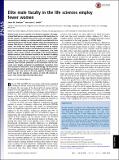| dc.contributor.author | Sheltzer, Jason Meyer | |
| dc.contributor.author | Smith, Joan C. | |
| dc.date.accessioned | 2015-02-05T15:43:44Z | |
| dc.date.available | 2015-02-05T15:43:44Z | |
| dc.date.issued | 2014-06 | |
| dc.date.submitted | 2014-03 | |
| dc.identifier.issn | 0027-8424 | |
| dc.identifier.issn | 1091-6490 | |
| dc.identifier.uri | http://hdl.handle.net/1721.1/93768 | |
| dc.description.abstract | Women make up over one-half of all doctoral recipients in biology-related fields but are vastly underrepresented at the faculty level in the life sciences. To explore the current causes of women’s underrepresentation in biology, we collected publicly accessible data from university directories and faculty websites about the composition of biology laboratories at leading academic institutions in the United States. We found that male faculty members tended to employ fewer female graduate students and postdoctoral researchers (postdocs) than female faculty members did. Furthermore, elite male faculty—those whose research was funded by the Howard Hughes Medical Institute, who had been elected to the National Academy of Sciences, or who had won a major career award—trained significantly fewer women than other male faculty members. In contrast, elite female faculty did not exhibit a gender bias in employment patterns. New assistant professors at the institutions that we surveyed were largely comprised of postdoctoral researchers from these prominent laboratories, and correspondingly, the laboratories that produced assistant professors had an overabundance of male postdocs. Thus, one cause of the leaky pipeline in biomedical research may be the exclusion of women, or their self-selected absence, from certain high-achieving laboratories. | en_US |
| dc.language.iso | en_US | |
| dc.publisher | National Academy of Sciences (U.S.) | en_US |
| dc.relation.isversionof | http://dx.doi.org/10.1073/pnas.1403334111 | en_US |
| dc.rights | Article is made available in accordance with the publisher's policy and may be subject to US copyright law. Please refer to the publisher's site for terms of use. | en_US |
| dc.source | National Academy of Sciences (U.S.) | en_US |
| dc.title | Elite male faculty in the life sciences employ fewer women | en_US |
| dc.type | Article | en_US |
| dc.identifier.citation | Sheltzer, Jason M., and Joan C. Smith. “Elite Male Faculty in the Life Sciences Employ Fewer Women.” Proceedings of the National Academy of Sciences 111, no. 28 (June 30, 2014): 10107–10112. | en_US |
| dc.contributor.department | Massachusetts Institute of Technology. Department of Biology | en_US |
| dc.contributor.department | Koch Institute for Integrative Cancer Research at MIT | en_US |
| dc.contributor.mitauthor | Sheltzer, Jason Meyer | en_US |
| dc.relation.journal | Proceedings of the National Academy of Sciences of the United States of America | en_US |
| dc.eprint.version | Final published version | en_US |
| dc.type.uri | http://purl.org/eprint/type/JournalArticle | en_US |
| eprint.status | http://purl.org/eprint/status/PeerReviewed | en_US |
| dspace.orderedauthors | Sheltzer, Jason M.; Smith, Joan C. | en_US |
| dc.identifier.orcid | https://orcid.org/0000-0003-1381-1323 | |
| mit.license | PUBLISHER_POLICY | en_US |
| mit.metadata.status | Complete | |
